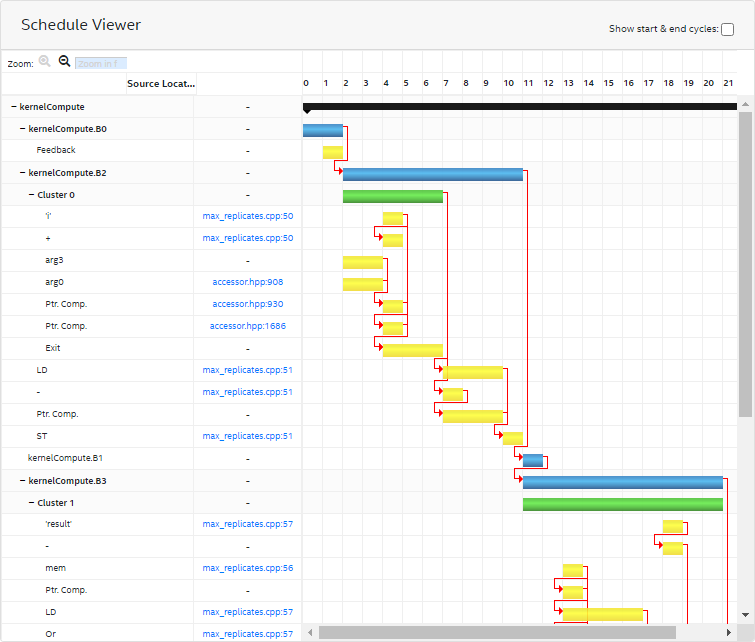Developer Guide
Intel® oneAPI DPC++/C++ Compiler Handbook for FPGAs
ID
785441
Date
5/05/2025
Public
Visible to Intel only — GUID: GUID-01C2E72A-89D7-4721-B944-4266F41599EE
Intel oneAPI DPC++/C++ Compiler Handbook for FPGAs Overview
Introduction To FPGA Design Concepts
Intel oneAPI FPGA Development
Getting Started with the Intel oneAPI DPC++/C++ Compiler for Intel FPGA Development
Defining a Kernel for FPGAs
Debugging and Verifying Your Design
Analyzing Your Design
Optimizing Your Kernel
Optimizing Your Host Application
Integrating Your Kernel into DSP Builder for Intel FPGAs
Integrating Your RTL IP Core Into a System
RTL IP Core Kernel Interfaces
Loops
Pipes
Data Types and Arithmetic Operations
Parallelism
Memories and Memory Operations
Libraries
Additional FPGA Acceleration Flow Considerations
FPGA Optimization Flags, Attributes, Pragmas, and Extensions
Quick Reference
Additional Information
Document Revision History for the Intel oneAPI DPC++/C++ Compiler Handbook for Intel FPGAs
Notices and Disclaimers
Throughput
Resource Use
System-level Profiling Using the Intercept Layer for OpenCL™ Applications
Multithreaded Host Application
Utilizing Hardware Kernel Invocation Queue
Double Buffering Host Utilizing Kernel Invocation Queue
N-Way Buffering to Overlap Kernel Execution
Prepinning Memory
Simple Host-Device Streaming
Buffered Host-Device Streaming
Refactor the Loop-Carried Data Dependency
Relax Loop-Carried Dependency
Transfer Loop-Carried Dependency to Local Memory
Minimize the Memory Dependencies for Loop Pipelining
Unroll Loops
Fuse Loops to Reduce Overhead and Improve Performance
Optimize Loops With Loop Speculation
Remove Loop Bottlenecks
Improve fMAX/II with Shannonization
Optimize Inner Loop Throughput
Improve Loop Performance by Caching Data in On-Chip Memory
Global Memory Bandwidth Use Calculation
Manual Partition of Global Memory
Partitioning Buffers Across Different Memory Types (Heterogeneous Memory)
Partitioning Buffers Across Memory Channels of the Same Memory Type
Ignoring Dependencies Between Accessor Arguments
Contiguous Memory Accesses
Static Memory Coalescing
Specify Schedule fMAX Target for Kernels (-Xsclock=<clock target>)
Create a 2xclock Interface (-Xsuse-2xclock)
Disable Burst-Interleaving of Global Memory (-Xsno-interleaving)
Force Ring Interconnect for Global Memory (-Xsglobal-ring)
Force a Single Store Ring to Reduce Area (-Xsforce-single-store-ring)
Force Fewer Read Data Reorder Units to Reduce Area (-Xsnum-reorder)
Disable Hardware Kernel Invocation Queue (-Xsno-hardware-kernel-invocation-queue)
Modify the Handshaking Protocol Between Clusters (-Xshyper-optimized-handshaking)
Disable Automatic Fusion of Loops (-Xsdisable-auto-loop-fusion)
Fuse Adjacent Loops With Unequal Trip Counts (-Xsenable-unequal-tc-fusion)
Pipeline Loops in Non-task Kernels (-Xsauto-pipeline)
Control Semantics of Floating-Point Operations (-fp-model=<value>)
Modify the Rounding Mode of Floating-point Operations (-Xsrounding=<rounding_type>)
Global Control of Exit FIFO Latency of Stall-free Clusters (-Xssfc-exit-fifo-type=<value>)
Enable the Read-Only Cache for Read-Only Accessors (-Xsread-only-cache-size=<N>)
Control Hardware Implementation of the Supported Data Types and Math Operations (-Xsdsp-mode=<option>)
Generate Register Map Wrapper (-Xsregister-map-wrapper-type)
Allow Wide Memory Initialization (-Xsallow-wide-device-globals)
Specify Schedule fMAX Target for Kernels (scheduler_target_fmax_mhz)
Specify a Workgroup Size (max_work_group_size/reqd_work_group_size)
Specify Number of SIMD Work Items (num_simd_work_items)
Omit Hardware that Generates and Dispatches Kernel IDs (max_global_work_dim)
Omit Hardware that Supports Global Work Offsets (no_global_work_offset)
Reduce Kernel Area and Latency (use_stall_enable_clusters)
Visible to Intel only — GUID: GUID-01C2E72A-89D7-4721-B944-4266F41599EE
Schedule Viewer
The Schedule Viewer displays a static view of the scheduled cycle and latency of a clustered group of instructions in your design. Use this report to view loop bottlenecks such as fMAX/II bottlenecks, memory dependency, and occupancy limiter.
To view the Schedule Viewer, click Views > Schedule Viewer.
In the Schedule Viewer:
- Columns depict the clock cycles.
- Rows display a list of kernels, blocks, clusters, and instructions ranked by the order of execution.
- The red arrows are dependency lines for each block, cluster, or instruction. The arrows show how each block, cluster, or instruction is dependent on other blocks, clusters, or instructions. Hovering over a node (bar) highlights its outgoing dependency lines.
- Each row represents a node and its start and end cycle.
- The bars are color-coded. Black indicates a kernel, blue indicates a block, green indicates a cluster, and yellow indicates an instruction.
Schedule Viewer


Parent topic: Review the FPGA Optimization Report